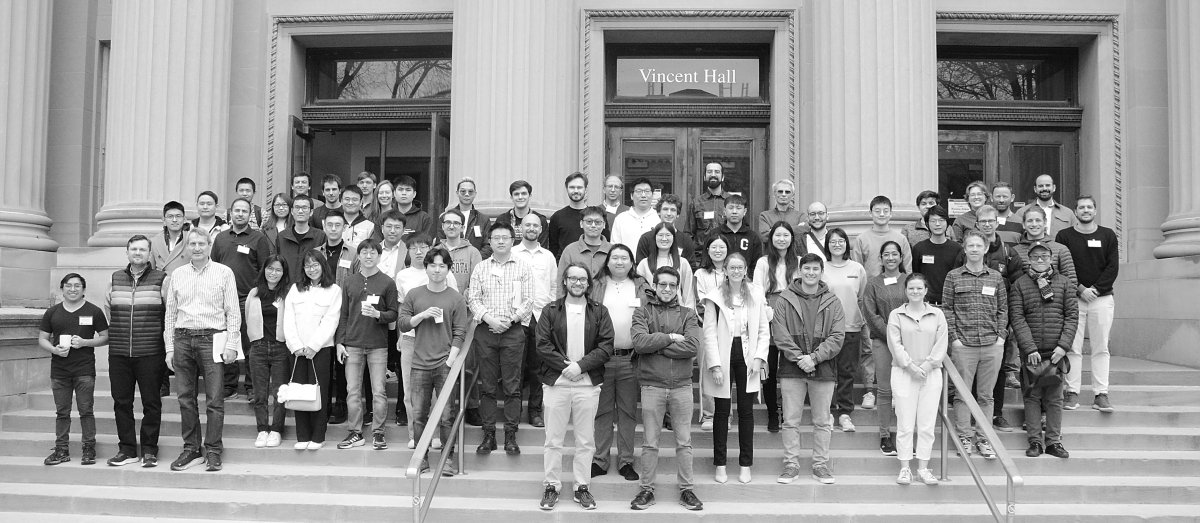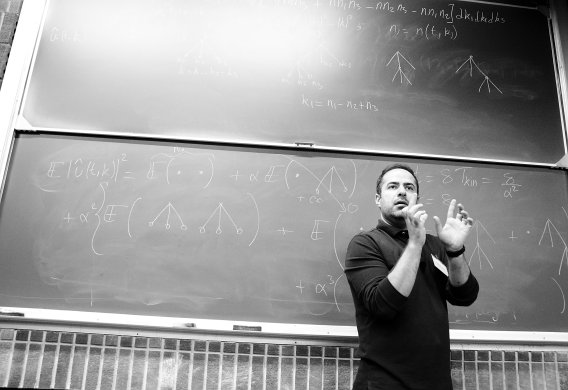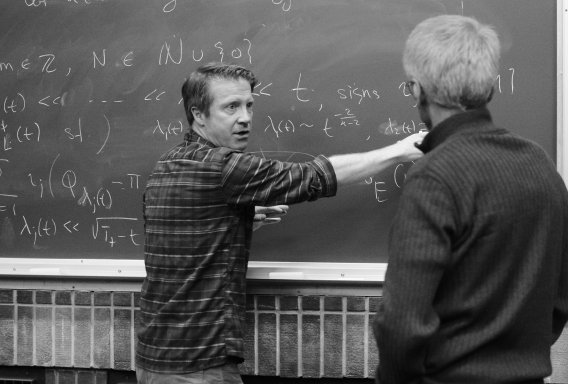Rivière-Fabes Symposium on Analysis and PDE
2024 Symposium: April 19th - 21st
The Rivière-Fabes Symposium on Analysis and PDE took place April 19th - 21st on the University of Minnesota – Twin Cities campus.

Speakers

The symposium's program consisted of two hour-long lectures from the following speakers:
- Zaher Hani (University of Michigan)
- Andrew Lawrie (MIT)
- Yumeng Ou (University of Pennsylvania)
- Vlad Vicol (Courant Institute)
Poster Session Presenters
View poster session presenters
Organizers
Dmitriy Bilyk, Max Engelstein, Hao Jia, Markus Keel (co-chair), Ru-Yu Lai, Svitlana Mayboroda, Peter Polacik, Mikhail Safonov, Daniel Spirn (co-chair), and Vladimir Sverak.
Talk titles & abstracts
+
Zaher Hani
Zaher Hani

Hilbert’s sixth problem for nonlinear waves*
Hilbert’s sixth problem asks for a mathematically rigorous justification of the macroscopic laws of statistical physics from the microscopic laws of dynamics. The classical setting of this problem is the justification of Boltzmann’s kinetic equation from Newtonian particle dynamics. This justification has been proven for short times, starting with the work of Lanford in 1975, but its long time justification remains one of the biggest open problems in kinetic theory.
If classical colliding particles are replaced with interacting waves, one formally obtains what is known as "wave kinetic theory”, which is sometimes also called "wave turbulence theory". This theory of statistical physics for waves has been developed, starting in the late 1920s, for wave systems that arise in various scientific disciplines like many-particle quantum physics, oceanography, climate science, etc. The central mathematical problem there is also the justification of a kinetic equation, known as the wave kinetic equation, starting from the Hamiltonian PDE that governs the corresponding microscopic system. In these two talks, we shall describe the state of the art of this problem, leading to a most recent joint work with Yu Deng (USC), in which we give the first instance of a long time justification of a nonlinear (particle or wave) collisional kinetic limit.
*Same title and abstract for both talks
+
Andrew Lawrie
Andrew Lawrie

The soliton resolution conjecture for equivariant wave maps*
The soliton resolution conjecture predicts that solutions to a wide class of dispersive PDEs asymptotically decouple into a dispersive component called the radiation and a localized non-dispersive component that exhibits multi-soliton structure. This problem is almost completely open for most of the dispersive equations where it is expected to hold. I will present a proof of soliton resolution for equivariant wave maps with values in the two-sphere. In this context, the solitons are harmonic maps (bubbles), and they decouple from each other and from the radiation by concentrating at different scales. It was proved in earlier work of Struwe, Côte, and Jia-Kenig, that solutions decouple into bubbles and radiation along a well-chose sequence of times. Our contribution is to show the resolution holds continuously-in-time. The proof uses a dynamical systems perspective — the main ingredient is a “no-return” lemma that prevents solutions from coming close to, then moving away from a multi-bubble configuration infinitely many times. As a byproduct of our analysis we prove that there are no pure multi-solitons in equivariance class k=1 and no elastic collisions between pure multi-solitons in any higher equivariance classes. This is joint work with Jacek Jendrej.
*Same title and abstract for both talks
+
Yumeng Ou
Yumeng Ou

Talk 1: Recent development on finite point configuration problems
Finite point configuration problems study existence or distribution of certain structures contained in a fractal set. These are fundamental questions in geometric measure theory and have seen many recent developments thanks to tools from Fourier analysis and combinatorics. A famous example of such a problem is Falconer's distance set conjecture, which says that a compact set $E$ in $\mathbb{R}^d$ with Hausdorff dimension greater than $\frac{d}{2}$ must generate a distance set of positive Lebesgue measure. Many exciting progresses have been made towards the conjecture in recent years, which have also led to improved understanding of other finite point configuration problems such as chains, trees, triangles, or other variants of distances. In this talk, I'll discuss some of these recent developments.
Talk 2: Getting closer to Falconer's distance set conjecture: a pair of approaches
Following the first talk, I'll give an in-depth discussion of a recent improvement to Falconer's distance set conjecture in dimension three and higher, which says that it's sufficient to assume the set to have dimension greater than $\frac{d}{2}+\frac{1}{4}-\frac{1}{8d+4}$. This is the first time that the higher dimensional result beats the two dimensional one (where the best-known threshold is $\frac{d}{2}+\frac{1}{4}$). I'll introduce two different approaches that we came up with, both relying on a recent radial projection theorem of Ren in a crucial way. Both proofs are joint work with Xiumin Du, Kevin Ren, and Ruixiang Zhang.
+
Vlad Vicol
Vlad Vicol

Talk 1: Shock formation and maximal hyperbolic development in multi-D gas dynamics
Talk 2: On anomalous diffusion
Schedule
+
Friday, April 19
Friday, April 19
3:00 – 3:30 pm - Coffee and Registration - 120 Vincent Hall
3:30 – 4:30 pm - Vlad Vicol - 16 Vincent Hall
4:30 – 5:00 pm - Coffee Break - 120 Vincent Hall
5:00 – 6:00 pm - Yumeng Ou - 16 Vincent Hall
+
Saturday, April 20
Saturday, April 20
8:30 – 9:00 am - Coffee and light breakfast - 120 Vincent Hall
9:00 – 10:00 am - Andrew Lawrie - 16 Vincent Hall
10:00 – 11:30 am - Coffee and Poster Session I - 120 Vincent Hall / Open Hallway
11:30 – 12:30 pm – Zaher Hani - 16 Vincent Hall
12:30 – 2:00 pm - Lunch Break (on your own)
2:00 – 3:00 pm - Yumeng Ou - 16 Vincent Hall
3:00 – 3:30 pm - Coffee - 120 Vincent Hall
3:30 – 4:30 pm - Vlad Vicol - 16 Vincent Hall
4:30 – 5:30 pm – Poster Session II
6:00 pm - Reception and Symposium Banquet, Campus Club (4th floor of the Coffman Memorial Union - Rooms A B C)
+
Sunday, April 21
Sunday, April 21
8:30 – 9:00 am - Coffee and light breakfast - 120 Vincent Hall
9:00 – 10:00 am - Zaher Hani - 16 Vincent Hall
10:00 – 10:30 am - Coffee - 120 Vincent Hall
10:30 – 11:30 am - Andrew Lawrie - 16 Vincent Hall
This Symposium was established in memory of our colleagues Nestor M. Rivière and Eugene B. Fabes.
The symposium is supported by the Riviere-Fabes fund at the University of Minnesota and by the National Science Foundation.